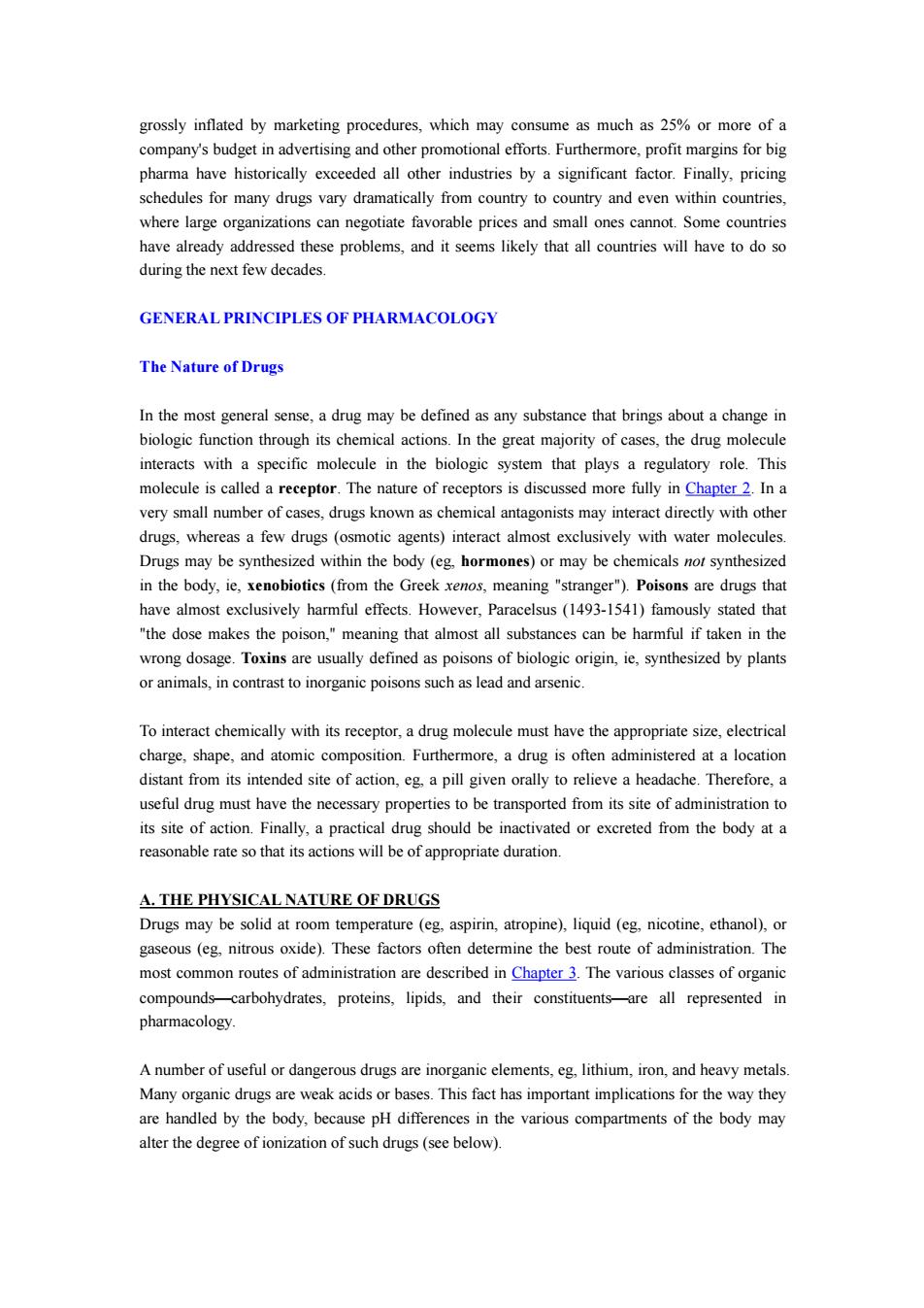正在加载图片...

grossly inflated by marketing procedures,which may consume as much as 25%or more of a company's budget in advertising and other promotional efforts.Furthermore,profit margins for big pharma have historically exceeded all other industries by a significant factor.Finally,pricing schedules for many drugs vary dramatically from country to country and even within countries, where large organizations can negotiate favorable prices and small ones cannot.Some countries have already addressed these problems,and it seems likely that all countries will have to do so during the next few decades. GENERAL PRINCIPLES OF PHARMACOLOGY The Nature of Drugs In the most general sense,a drug may be defined as any substance that brings about a change in biologic function through its chemical actions.In the great majority of cases,the drug molecule interacts with a specific molecule in the biologic system that plays a regulatory role.This molecule is called a receptor.The nature of receptors is discussed more fully in Chapter 2.In a very small number of cases,drugs known as chemical antagonists may interact directly with other drugs,whereas a few drugs (osmotic agents)interact almost exclusively with water molecules. Drugs may be synthesized within the body (eg,hormones)or may be chemicals not synthesized in the body,ie,xenobiotics (from the Greek xenos,meaning "stranger").Poisons are drugs that have almost exclusively harmful effects.However,Paracelsus (1493-1541)famously stated that "the dose makes the poison,"meaning that almost all substances can be harmful if taken in the wrong dosage.Toxins are usually defined as poisons of biologic origin,ie,synthesized by plants or animals,in contrast to inorganic poisons such as lead and arsenic. To interact chemically with its receptor,a drug molecule must have the appropriate size,electrical charge,shape,and atomic composition.Furthermore,a drug is often administered at a location distant from its intended site of action,eg,a pill given orally to relieve a headache.Therefore,a useful drug must have the necessary properties to be transported from its site of administration to its site of action.Finally,a practical drug should be inactivated or excreted from the body at a reasonable rate so that its actions will be of appropriate duration. A.THE PHYSICAL NATURE OF DRUGS Drugs may be solid at room temperature (eg,aspirin,atropine),liquid (eg,nicotine,ethanol),or gaseous (eg,nitrous oxide).These factors often determine the best route of administration.The most common routes of administration are described in Chapter 3.The various classes of organic compounds-carbohydrates,proteins,lipids,and their constituents-are all represented in pharmacology A number of useful or dangerous drugs are inorganic elements,eg,lithium,iron,and heavy metals. Many organic drugs are weak acids or bases.This fact has important implications for the way they are handled by the body,because pH differences in the various compartments of the body may alter the degree of ionization of such drugs (see below).grossly inflated by marketing procedures, which may consume as much as 25% or more of a company's budget in advertising and other promotional efforts. Furthermore, profit margins for big pharma have historically exceeded all other industries by a significant factor. Finally, pricing schedules for many drugs vary dramatically from country to country and even within countries, where large organizations can negotiate favorable prices and small ones cannot. Some countries have already addressed these problems, and it seems likely that all countries will have to do so during the next few decades. GENERAL PRINCIPLES OF PHARMACOLOGY The Nature of Drugs In the most general sense, a drug may be defined as any substance that brings about a change in biologic function through its chemical actions. In the great majority of cases, the drug molecule interacts with a specific molecule in the biologic system that plays a regulatory role. This molecule is called a receptor. The nature of receptors is discussed more fully in Chapter 2. In a very small number of cases, drugs known as chemical antagonists may interact directly with other drugs, whereas a few drugs (osmotic agents) interact almost exclusively with water molecules. Drugs may be synthesized within the body (eg, hormones) or may be chemicals not synthesized in the body, ie, xenobiotics (from the Greek xenos, meaning "stranger"). Poisons are drugs that have almost exclusively harmful effects. However, Paracelsus (1493-1541) famously stated that "the dose makes the poison," meaning that almost all substances can be harmful if taken in the wrong dosage. Toxins are usually defined as poisons of biologic origin, ie, synthesized by plants or animals, in contrast to inorganic poisons such as lead and arsenic. To interact chemically with its receptor, a drug molecule must have the appropriate size, electrical charge, shape, and atomic composition. Furthermore, a drug is often administered at a location distant from its intended site of action, eg, a pill given orally to relieve a headache. Therefore, a useful drug must have the necessary properties to be transported from its site of administration to its site of action. Finally, a practical drug should be inactivated or excreted from the body at a reasonable rate so that its actions will be of appropriate duration. A. THE PHYSICAL NATURE OF DRUGS Drugs may be solid at room temperature (eg, aspirin, atropine), liquid (eg, nicotine, ethanol), or gaseous (eg, nitrous oxide). These factors often determine the best route of administration. The most common routes of administration are described in Chapter 3. The various classes of organic compoundscarbohydrates, proteins, lipids, and their constituentsare all represented in pharmacology. A number of useful or dangerous drugs are inorganic elements, eg, lithium, iron, and heavy metals. Many organic drugs are weak acids or bases. This fact has important implications for the way they are handled by the body, because pH differences in the various compartments of the body may alter the degree of ionization of such drugs (see below)